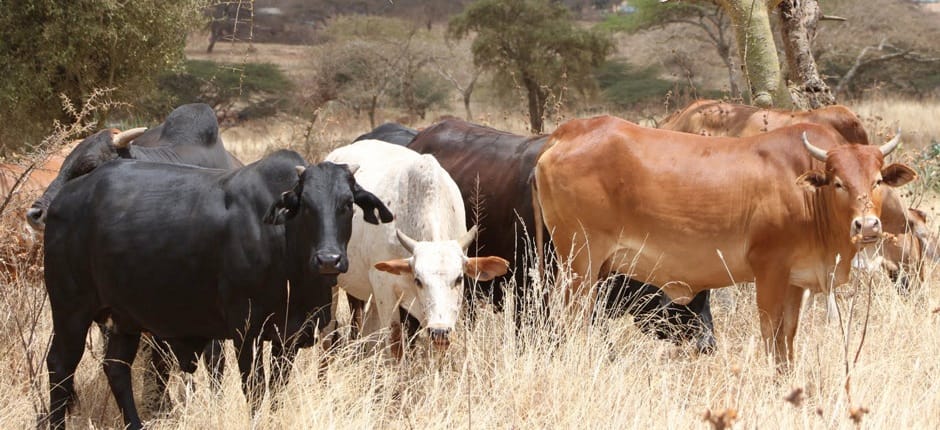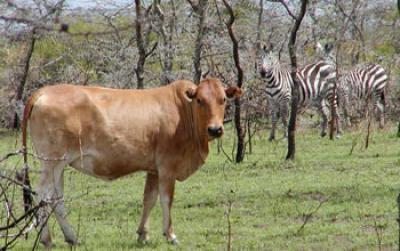Coexisting With Cattle

On the grasslands of East Africa cattle are sometimes helped by wildlife, whereas at other times, wildlife compete with cattle: it’s all about timing.
The articles below report on a simple experiment that tested whether wildlife and cattle actually compete for food.

On the grasslands of Africa, like everywhere in the world, multiple wildlife species evolved together, in a way that forced them to compete for, and to share, food and other resources. As our human species became active in agriculture, we wiped out wild animals because we believed that these competed with domestics, like cattle, for food.
This debate about whether livestock and wildlife compete generates the primary source of human-wildlife conflict: whether the conflict is perceived or real, people think that wildlife harm domestics, and vice-versa, and wildlife populations are inevitably on the losing side.
In West Texas a few ranchers, believing that elk compete with cows, got a law passed to permit elk eradications.
Texas Parks & Wildlife Department, and Texas Bighorn Society, in a sincere effort to help Desert Bighorn Sheep and acting similarly to the ranchers following this time-honored practice, also are trying to eliminate all exotics, like aoudad, and native elk on all state-managed lands. On the WMA next to Circle Ranch, mule deer does are being ‘culled’, large predators are shot or trapped, and all domestic animals have been removed, in order to “help” favored species.
Eradication efforts like these have done huge damage to biodiversity conservation. But mixed grazing systems involving livestock and wildlife have been found in this study to be beneficial for biodiversity and for both groups of animals where management is attentive.
The study was conducted on savannas of East Africa. These are renowned for species diversity. It found that cattle do compete with some herbivores like zebras and gazelles during the dry, dormant season when food quality is low. But during the wet season, wildlife grazing benefits cattle by improving the quality of the forage in two ways. (1) Certain species will remove low-quality forage which cattle cannot easily utilize. And (2) that removal stimulates plants to grow and produce more forage of the type that cattle prefer.
In general, large plant-eaters (herbivores) weighing more than 15 pounds are (1) grazers which eat grass, (2) browsers which eat foliage on trees and shrubs, or (3) mixed feeders which alternate between both according to season. So, when we speak of wildlife we have to distinguish between grazers, browsers, and mixed feeders because they don’t all eat the same things. And even the animals that eat the same thing differ in size, how they eat, and how they act while they eat.
Feeding behavior of one will permit the presence of something else. Smaller animals generally require higher-quality food through the year. Larger-bodied species generally tolerate feeding on a wider range of habitat. Ruminants, which have multi-compartmented stomachs for digesting food, usually require higher-quality food. Non-ruminants like horses and zebras have faster digestive systems which enables them to eat fibrous material: Thus, they can occupy a wider range of habitats than ruminants of the same size. Although species sometimes compete as a result of this, the diversity often results in a mutual benefit, in which at least one species benefits and none lose: this contributes to ecosystem stability.
The study talks about how large grazers like buffalo and elephants were found to influence what cattle ate and how cattle performed in weight gain. While cattle-wildlife interactions can be competitive, they can also be mutually beneficial, depending on how many animals of each type there are, where those animals are at a given moment, how densely-packed they are at that moment, and where they are found across their shared rangeland. These insights offer a refreshing view which shows us that when properly managed, diverse animal populations help each other.
This mutual benefit is what scientists call “facilitation.” It works through a process called “grazing succession,” which happens in these grasslands when the larger animals, like buffalo and zebra, feed through the grass, eat coarse material, and trample down the tall plants. This clears the way for other species to feed on the now-exposed plant parts that are of higher quality. In this example, one species’ feeding actions improved the opportunity of other species to feed.
So for example an elephant, a buffalo or a zebra opens up the paths, whereupon the little antelopes can go in and find something to eat. The latest thinking on the grazing succession phenomenon is that it is like a push-pull of interactions: The big animals create plant conditions that then attract the smaller animals which rapidly remove the high quality plants and this causes the larger species to move on. These larger species, having a wider dietary tolerance, or ability to eat lower-quality food, can continue to move along and find what they need at the front of the grazing succession.
It is not necessarily true that the facilitating species is the larger species. For example, it was observed that zebras facilitate grazing conditions for cattle during the wet season. This is because zebras are not ruminants and so they can process fibrous grass stems whereas cattle can’t, and this benefits cattle.
The authors conclude that a mix of animals: greater biodiversity of animals that differ in (1) body size, (2) what each eats as between grazing, browsing or a combination of both, and (3) as to different digestive systems, will provide managers with opportunities to help the community of animals to enhance biodiversity, enhance animal production and enhance habitat.
The authors conclude that in developed countries it is standard practice for rangeland managers to encourage a mixture of native and non-native plants. The next step they say, is to do this with animals: this will require bold experimentation and thinking outside of the box, to use a combination of native and exotic animals to enhance animal performance and the development of habitat to make our rangelands more productive.
For years, planned graziers like Allan Savory have offered this thumbnail description of planned grazing: it is about getting the right animals, to the right place, at the right time, in the right numbers, with the right behavior, for the right reasons.
Those who confidently kill elk to help cattle, or destock our ranges to help wildlife, or who believe they help Desert Bighorn Sheep by removing elk, exotics and domestics, or who kill wild burros and longhorn at Big Bend Park or on state-managed public lands, should consider what has been found on the savannahs of East Africa: properly managed animal diversity helps plants because plants need animals as much as animals need plants.
Princeton University has confirmed these findings in tests using burros as more manageable substitutes for zebra and wild horses:
http://www.princeton.edu/main/news/archive/S32/93/41K10/index.xml?section=fea…
What an irony that this cutting-edge range and wildlife management thinking must come to us from the Third World, and what a shame it is so contrary to what is being practiced in the United States generally, and on our far-West Texas ranges in particular.
Please read these three articles:
Coexisting with Cattle
African Wild Ungulates Compete with or Facilitate Cattle Depending on Season
Grazing Zebras Versus Cattle: Not So Black and White
